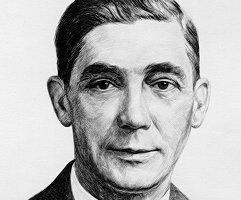TALES AND LEGENDS OF THE MOUNTAIN KINGDOM: William Munroe Archibald, The Flying Businessman
Piecing a story together using disparate sources can be challenging at the best of times, but sometimes during the research process a seemingly innocuous mention of an unrecognizable name leads to a sudden burst of information and inspiration. My stumbling upon William Archibald is one of these cases.
Rossland was not the most happening place in the 1920s. The post-mining blues had set in and so had the Great Depression. Thanks to the efforts of Mayor Alex Pitt a decade earlier, Rossland was settling into being a bedroom community of Trail which was, of course, the home of the largest employer in the area, the Consolidated Mining and Smelting Company. The CM&S Co. was acquiring new properties hither and yon, always seeking to expand its influence and assets.
Now, I have also written about the flying steamshovel – the actual flying steamshovel, from which the hotel/pub take its name. That little piece of aviation history, alas, was never really made that famous despite how important it seemed at the time, but even though the steamshovel incident ended in disaster, Rossland is connected to another piece of aviation history that made it into such honoured halls as the Canada’s Aviation Hall of Fame. It’s a small connection, but a significant one, and it would change the face of mining forever.
The man behind all this was named William Munroe Archibald, and he would become one of Canada’s brightest aviation pioneers. And he was a Rossland resident.
Born in Truro, Nova Scotia on February 23, 1876, to parents Alexander Archibald and Alice Munroe, young William, also called “Roe”, was given a fine university education at Montreal’s McGill University, where he studied mining engineering. He made the rounds of various mining camps until he ended up in Trail in 1911, and made his home in Rossland. He was on the team that went around investigating different mining sites for the CM&S Co. and then in 1928 he became the general manager of mines for the company.
It was in 1929 that Roe’s rise to local and national fame would begin. Still working as the company’s general manager of mines, at the age of 53, he went and learned to fly. Airplanes. And he would then go pioneer the use of planes in mining exploration.
I can’t find anything about what suddenly inspired Roe to do this, but it just goes to show you’re never too young to be an innovator or pioneer.
He went to Toronto to learn to fly, and the de Havilland Aircraft company, and he bought one of their aircraft. He came back to Trail and started up the Cominco Flying Service.
Now here is where things get confusing for the old historical researcher. Some sources say he started up the Service in Rossland, which included a school of sorts where mining engineers were trained to use planes to suss out potential mining sites. Others say that the Service was started in Creston. Obviously, there is nowhere to land a plane in Rossland, so there couldn’t have been an actual flying school in the Mountain Kingdom, but there are plenty of flat areas in Creston to put an airstrip. Perhaps there were Service offices in Rossland.
But there must have been a local airstrip somewhere because Roe, once he bought his plane, used it to commute between Creston, where he had recently relocated, and Trail for work every day starting in 1929. In fact, it was in this year that Roe made one of his many “firsts”: he was the first man to fly an aircraft into the Kootenays. In 1931, he became the first man to make a coast to coast journey across the country in a wheeled plane.
The Cominco Flying Service was a hit. It was such a hit that the program developed quickly, and before long, in 1932, there were 10 planes in the service, which employed WWI Air Force veterans as pilot instructors.
Roe had a few other firsts, too. He was the first pilot to plot and fly an air route into Stewart, BC, and Ketchikan, Alaska. Both were important mining locales at one point, and they are both in close to proximity to Hyder, Alaska, which was a mining centre between the 1920s and 1950s.
He also made many cross-Canada flights that earned him the name “Canada’s Flying Businessman.” In 1935, Roe was awarded the prestigious McKee Trophy, which was an aviation award that celebrated achievements in the realm of aerospace operations.
Roe would go on to explore, by plane, Parts of Canada’s sub-Arctic region around Yellowknife, in the Northwest Territories, and he would eventually acquire another nickname, “Father of the Yellowknife Goldfields” as his explorations would be a key factor in opening up mining in that area.
He retired from Cominco in 1938. He would die in Toronto 11 years later at the age of 73, after taking up a position as a government liaison in Cuba during WWII. Posthumously, in 1974, he was inducted into the Canadian Aviation Hall of Fame, which had been established the year before.
And there you have another piece of local history to make you go “hmm.”
Sources:
http://en.wikipedia.org/wiki/William_Munroe_Archibald
http://cameraworkers.davidmattison.com/getperson.php?personID=I596&tree=cw18581950
http://www.yellowknife.ca/Assets/City+Clerks/Street+Naming/ListofUsedStreetNames.pdf

























